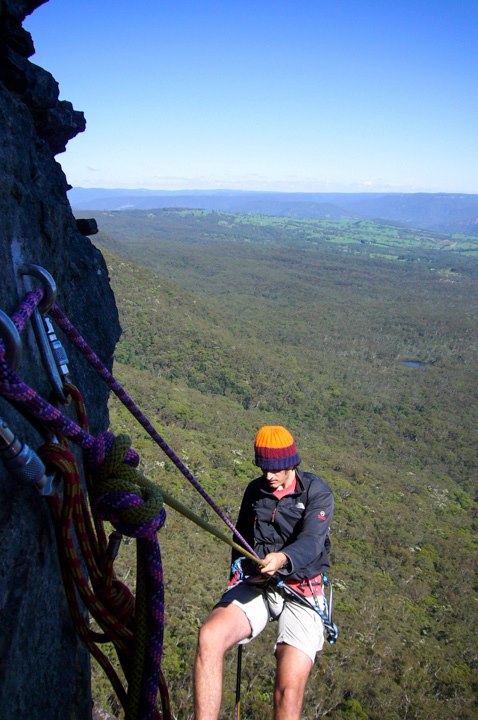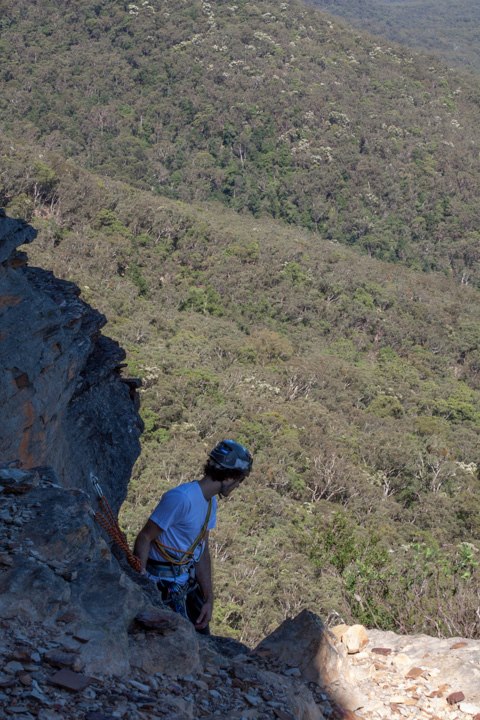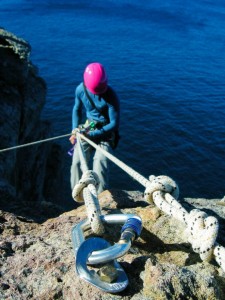When you're young, safety is surviving once. When you get older, safety is you and all your friends surviving for fifty years.
- Mike Law
If you canyon or climb for long enough, descending with ropes becomes routine. It's easy to forget just how serious it becomes, the moment you unclip your safety tether and place complete reliance on the anchor and your equipment. For people who've never done it, abseiling is scary, and maybe it should still be scary if you do it every weekend. Is real safety possible? Should we be trying to keep things simple, or using more advanced rigging? Only experience can help answer these questions for a particular descent scenario. In this article, I'll outline some procedures and techniques that can help us on the road to safer abseiling.
The Big 'S'
Oh, shit!
- Jim Madsen, moments before rappelling off the end of his rope in Yosemite and falling hundreds of meters to his death.
The most horrific accident in abseiling is coming off the rope, either abseiling off the ends, or clipping your device to the rope incorrectly due to distraction. To prevent this, the two main guidelines are:
- Always tie knots in the ends of the rope. I don't care how recently you checked the rope's middle marker, or how sure you are that you saw the ends hit the ground. Just do it. (The exception many of us make is on short wet canyon abseils with clear visibility).
The traditional stopper knot, a double fisherman's, is maybe a little dinky for the purpose (it's been demonstrated that it can pull through some belay devices?) so I prefer to do an extra wrap and tie a triple fisherman's, or go the whole hog and tie big loops in the end, like a figure 8 on a bight. The advantage of a loop knot is that, if you do end up at the end of the rope, you can stand in them, or clip into them for safety.
The corollary to always tying knots, is to always remember to untie them before you try to pull the rope. If you forget, the stopper knot will probably jam against the anchor, and you'll be in a "little 'S'" situation. - Always weight your abseil device before you unclip from the anchor. OK, this isn't always possible, but it is 95% of the time. Make sure you have a long safety tether, and after rigging your device, pull in all the slack until it's almost hard up against the anchor. Abseil a little bit to make sure it's set up correctly, then just before the anchor goes beyond reach, unclip your safety.
If you can make a habit of these two things, you'll hopefully end up with near misses rather than accidents.
The Little 'S'
Far out, it's stuck!
- Me
A jammed abseil rope is perhaps responsible for more mini-epics than anything else. It can ruin your day, really quickly. It can happen in two situations:
Throwing the ropes
If it's windy, or if there's trees and cracks everywhere, sometimes you'll throw the ropes off the edge and they'll get disgustingly tangled in something. There's a few things you can do here.
- Throw the rope in 'quarters '. After halving the rope through the anchor, divide each end into halves again by coiling each into two butterfly coils (so you have four coils in total). For each end, throw the coil closest to the middle first (so you have a big loop hanging over the edge) and then throw the end coil. This method seems to help prevent tangles and snags.
- A tip from Mike Law for windy abseils, is to weight the ends of the rope by tying something heavy to the end, e.g. some climbing rack.
- If you're really concerned (because of high winds or very broken terrain) you shouldn't throw the ropes at all, but take the coils with you as you lead the abseil, and pay out slack as you need it. You can improvise a rope bag, by shoving the rope into a backpack, which you then hang "Mae West" style from your belay loop. Or you can flake the rope into a sling "holster", which you can clip to your harness. Or, use a purpose-made rope bag. They're a revelation.
- If you're on abseil, and despite your efforts the rope has still ended up tangled in a tree or out of sight around a corner, it's vital to stop and deal with it while you're still above the mess. If you descend below the tangle, all of a sudden the rope will be being pulled up tight out of your hands and you'll be stranded.
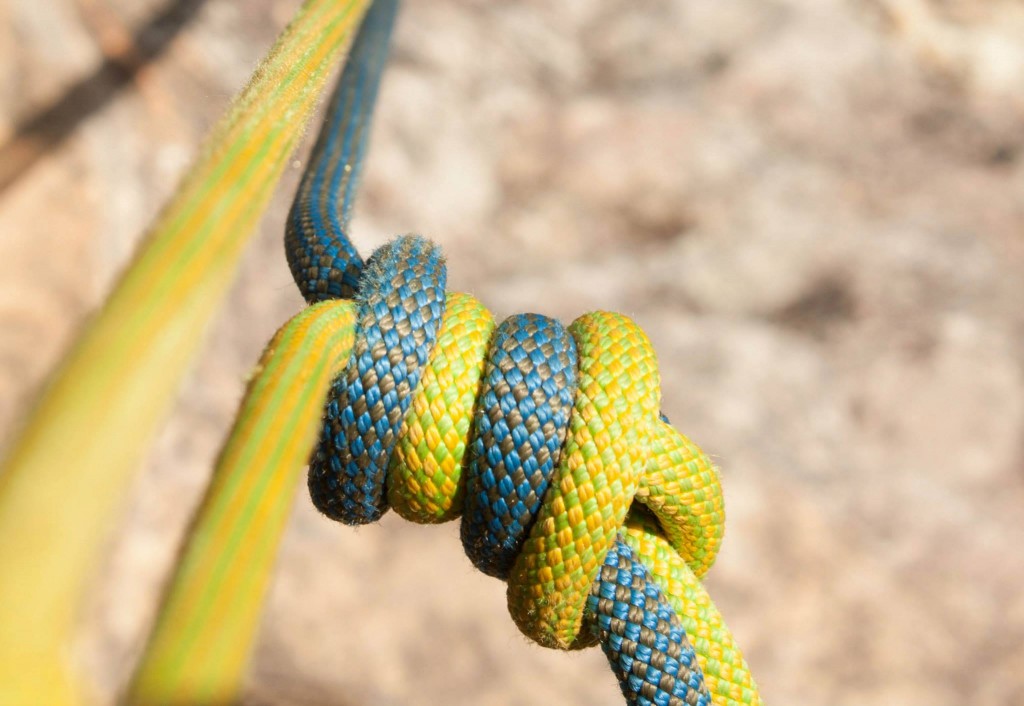
Pulling the ropes
It's the classic story. You've all successfully descended the rope, you're maybe even on the ground ready to go home, when you go to pull the ropes and...they won't budge. Stuuuck! So, what can you do.
- Call for a helicopter rescue.
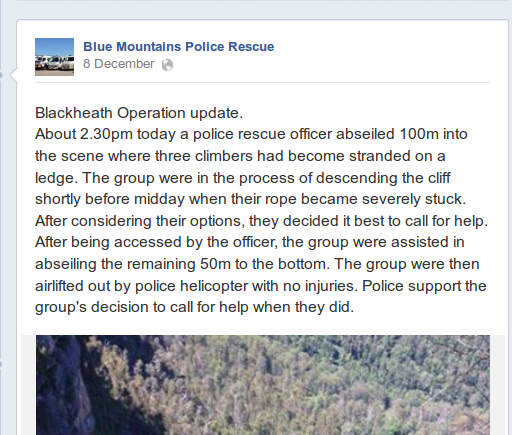
- Prevent it before it happens. Stop using a double fisherman's knot and tie an overhand, they really do get stuck less. Test the pull down before the last person abseils. In addition, the last person down can adjust the ropes through his device, so the knot is positioned over the edge. He can also prevent them from being sucked into a crack by judicious positioning.
- If you're all on the ground and they won't pull, pull smarter. Stand back as far as possible (to reduce the angle the ropes are bent over the edge) and flick the rope around to try and free it.
- If that doesn't work, pull harder. Ropes are tough. Flick it around violently and yard on it with full bodyweight and a couple of people. You might even try a 3-1 mechanical advantage system to haul to rope with even more force.
- If you still have both ends of the rope in reach, someone will have to draw a short straw and ascend back up there.
- If one end of the rope has been pulled out of reach, well, you're up shit creek...but you may be able to improvise a paddle. If you have enough equipment, it might be possible to climb the abseil route, with someone leading on the end of the rope you have. If they reach the stuck part, they can construct an anchor in a better position and abseil back down.
- It's almost certainly a bad idea to try and ascend the stuck end of the rope. Though, there are plenty of stories of people doing this and surviving, to find the rope was stuck on a twig or pebble or something equally horrifying.
- As a last resort, pull down as much as you can, and cut it. Use this end of the rope to continue descending. You brought a knife, right?
Anchors
Despite the dozens of bad anchors out there, anchor failure is thankfully extremely rare, a testament to the holding power of manky carrots and worn shrubs, and how little is required to hold body weight.
It's usually pretty obvious that an anchor is past its use-by date, and you should always have a knife, spare webbing, and some mallions, old biners, or rap rings handy to make a new anchor. Static rope "sheathed" in tubular webbing will last the longest. Old bolts are harder to deal with, but as long as there's more than one you're probably fine.
For more information I would check out the Safer Cliffs bolt identification guide, and read John Long's Climbing Anchors (there's a 3rd edition now) which has a great section on natural tree and rock anchors, and is COMPULSORY reading for any aspiring trad climber.
Danger Unprotected Cliffs
So, you need to set up this abseil, and the bolts are down there, leaning out over the void (sensibly positioned to avoid a "little 's'" situation). To rope up, or not to rope up?
It's easy to be lazy and scramble unprotected around cliff edges while getting in to position. After all, we're experienced, we know what we're doing! But in the long run, you're really taking a lot of risk by making a habit of walking around cliff edges unroped. Several experienced and competent climbers have died in Australia after slipping while negotiating a clifftop - including one very recent fatality at Moonarie.
On the other hand, there is a strong argument for simplicity. You could flake the rope, set up a safety line, be belayed down, tie it off, get everyone to clip in and move to the anchor, tear it all down...and in the confusion some people end up unattached anyway, and all the while those afternoon thunderstorms are getting closer. Or, you could just carefully walk over to the anchors. The best example of this dilemma is probably the slot on the Boar's Head abseil route. It's basically walking, with your feet on either side of a narrow gap in the floor that drops 60m down. Belaying people through the slot adds significant complication.
I would suggest that if you're worried that setting up a safety line or belaying for those last few meters back from the cliff edge is too time consuming, your party is probably too big.
Another way to encourage safety, is to set up the anchor with a big and obvious master point, with plenty of room for clipping. This will encourage people to clip their safety tether in as soon as they see it.
Backing Up An Abseil
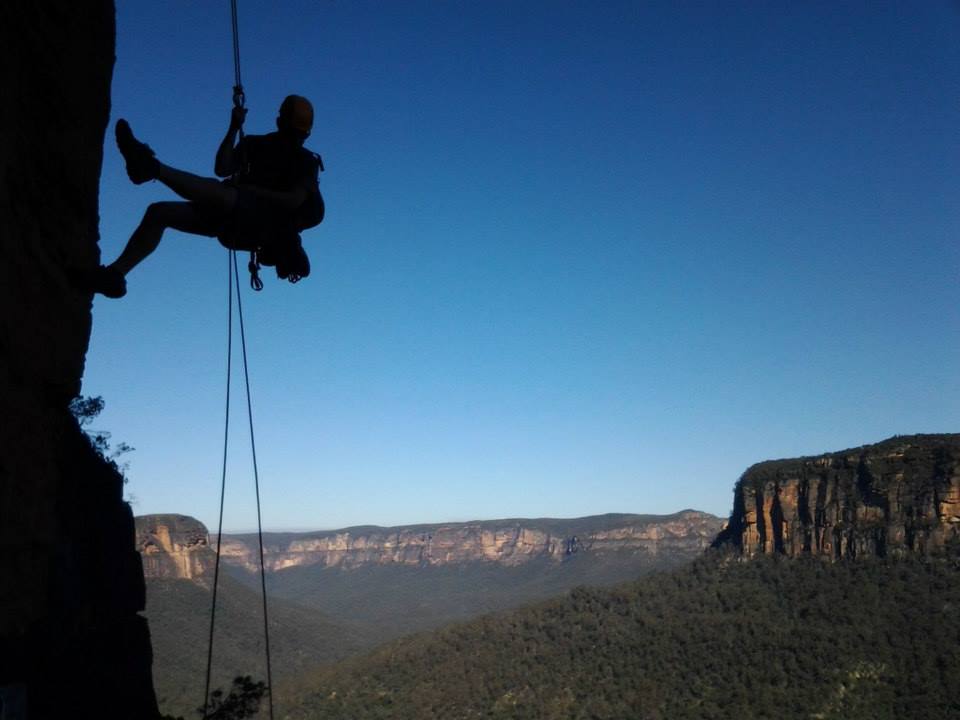
There's some good discussion of this issue in this Chockstone tech tip article.
Prusik Backups
Everyone mostly agrees these days that a prusik above the abseil device is a bad idea, as unless the length is exactly right it can easily get stuck out of reach, stranding the abseiler (unless they're smart enough to wrap the rope around their foot and stand up).
The fashion these days is the 'third hand' backup, with a short prusik tied as an autoblock below the belay device and clipped into a harness leg loop, is a creative solution to this problem. It doesn't get jammed and is never out of reach. There are a couple of problems with this. As well as the questionable practice of using a leg loop as a rated clip in point, it often doesn't actually work as a backup!
The thing is, in an emergency, you're either going to flip upside down, or instinctively curl into the foetal position. In both these situations, your harness leg loops will be brought up next to your belay device, and unless you got the length of your autoblock prusik exactly right it will be pulled into your belay device and unable to jam.
The only time you should use a prusik backup, is if you are going to extend the belay device with a sling, one method of which is shown here by Petzl. This is now what most climbing guiding associations teach as best practice.

Easy, fast, and secure if done properly. However, I bet most people have never actually caught an abseiler with one...and so don't actually know how to do it properly.
One prominent group of canyoners (also a group of prominent canyoners, hehehe) often chooses not to provide bottom belay on abseils, due to the risk of rockfall to the belayer. In many situations, this is a significant risk and should be seriously considered. However, In Blue Mountains sandstone canyons, I feel the rockfall risk is very low, and personally I am willing give up a little bit of personal safety to help ensure the team's safety.
James Bultitude suggests that the fireman's belay often isn't as secure as people expect, and cites this test. Issues like large weight differences, long pitches (where rope stretch comes into play) and low-friction devices (the Kong Hydrobot is notorious) can make it very difficult to impossible to hold someone on a fireman's belay. If you really want security for less confident abseilers, a top belay is really the best option.
Single Rope Techniques
The Stone Knot
This baby may seem like a gimmick, but it really is an excellent technique to know.

Learn all about this knot on Canyoneering USA. By tying this in your doubled abseil rope, you instantly fix it as two single strands. This has several advantages.
- With a person on each line simultaneously, big groups can complete abseils significantly faster.
- A second rope is always available, for rescue, or for top belays for beginners (more on this later).
- You can use mechanical ascenders and autolocking descenders (Grigris) on a single rope, which can make the lead abseiler's task much easier when they don't know where the next anchor is, or if they have to pendulum or traverse.
- If you are worried about the rope cutting on a dangerous edge, you can tie a stone knot but still rap on both strands for additional security (from Tim Volmer).
Note that the last person does have to untie the knot, and descend on double strands.
An alternative from Pete Butcher, is to grab both strands of the rope below the anchor and tie a huge overhand knot. This gives you the advantage of a second well-positioned masterpoint for clipping in or belaying. However, it will be much harder to undo.
The Reepschnur Method
Now that you have one single rope technique in your toolkit, you should learn how to do blocked abseils, also called the Reepshnur rappel. This allows you to do full rope length abseils with a single rope, and a skinny lightweight cord used to pull it down afterwards. The climbing method traditionally uses a backed-up knot block and here is an excellent discussion. The canyoneering method traditionally uses a biner block, and again Canyoneering USA has a good discussion here.
The elephant in the room with the Reepschnur method, is the rope retrieval is always difficult and worrying. As you pull down, you feel the huge knots and carabiner pop past edges and snags, hoping like hell that nothing gets stuck! You need to carefully consider whether this method is suitable for the abseil route you'll be taking. Some very experienced people - including a certified canyon guide with international experience - have had their pride taken down a notch, after getting their sophisticated biner block rigging very stuck.
The skinnier ropes are, the more they tend to tangle, and skinny pull cords can get really tangled. A canyoning or caving style rope bag for your pull cord is practically mandatory - a cheap nylon stuff sack will work. Throw the abseil rope, then clip the pull cord rope bag to your harness as you abseil. Once there's a clean drop to the ground, unclip it and throw it down.
The last step - throwing the rope bag once you get to a clean drop - is actually quite important. When you abseil a single strand on a free-hanging abseil, you'll probably spin a little as you descend. While fun, if the pull cord rope bag is clipped to your harness, you'll wind the pull cord around the abseil rope in an attractive spiral, and make them impossible to retrieve! (This happened to us recently on a Pierce's Pass rap route - there was so much friction, James had to space haul on the 6mm pull cord with full bodyweight, using our micro ascenders!) It's probably advisable for the first person to abseil without the pull cord, and then be ready to hold it out of the way after the last person throws it down.
The CUSA article discusses backing up the abseil to the anchor, for everyone except the last person. This is an excellent habit to get in to - people can and do accidentally clip into the non-blocked side!
It also discusses the technique of exactly setting the rope length on wet abseils, so you can leave the end un-knotted and swim off the end of the rope. This works great in abseils that end in finger-numbing cold deep pools, even if you get the length a bit wrong you'll just fall into the water (ha ha ha, don't actually test this). Personally I wouldn't consider doing it on anything bigger than the final abseil in Empress Canyon.
I once had a friend carry in a 200m rope for the big abseil on Bungonia Main. For goodness' sakes don't do this to yourself! Start thinking about skinnier cord for those big remote canyons with huge exits.
Spare Ropes
Some people advocate always bringing a second rope, as long as the longest abseil, for rescue and in case your main rope is damaged. In my opinion, this is a case of "solving" a problem by thinking about it for thirty seconds in an armchair, and just isn't necessary.
However, having a rope that's a bit longer than you need isn't a bad idea. It will give you more options in case of the unexpected, allowing you to potentially link pitches or use alternative anchors. Plus, you'll be able to cut lengths of the end to leave behind at anchors if required.
If your rope gets badly damaged, tie off the damaged section in a butterfly loop, and start doing biner blocks, so you can abseil on the good end and use the damaged end as the pull cord.
For rescue, if you're isolating strands with a stone knot, you already have a spare strand to rescue on. Except for the last person, but in that case everyone else is at the bottom, and a second rope won't do you much good.
If you're abseiling with a biner or knot block and using a pull cord, well, you already made the decision to go light and take the extra risk, and it didn't work out. If the main rope is damaged, you'll need to tie the damaged section off in a butterfly knot, and start passing the knot on every rap. If rescue is required, either rap the pull cord and pray (potentially, you could pull it back up, double it for safety, and use a Munter hitch for extra friction) or down-prusik the main rope.
Prusiks and Ascending
The traditional wisdom is that if there's a "problem", the leader will have a set of prusiks (at least two long and one short, right?) and be able to tie them around both strands, ascend, and "fix" it. It's darkly hilarious sometimes - "Of course we have prussics [sic] and a first aid kit, we were taught to always bring them!" No idea how to use them, but we have them.
It's interesting to think about exactly what scenarios (besides stuck ropes) where you would actually have to ascend the rope, and exactly what you would do? If the last person has gotten injured and stuck on abseil, you better have a really good plan...
For starters, your prusiks are probably too short. Any serious self-rescue technique will probably require a prusik Munter-mule overhand at some point and you'll want your long prusik to be a 2m loop. At least 1m.
They're also probably too thick. Prusiks require a big difference in size between the prusik cord and the rope to work properly. If you're using slippery 9mm static, 7mm accessory cord often won't grip well, and you'll even have problems with 6mm accessory cord in many situations. 5mm is light and skinny but not confidence inspiring. On the other hand, 7mm cord is significantly stronger. I'll leave the decision up to you, but be aware of these issues.
Thirdly, anyone who has prusiked more than one meter in their life knows that it sucks dogs balls. It sure would be nice to have a single rope to ascend and a couple of modern micro ascenders, such as a Micro Traxion or Tibloc.
Rescue Techniques
Now real roped self-rescue is clearly out of scope here. Do always remember the first rule, which is not to become an additional casualty yourself.
If you are interested, I would look up tandem rappelling, and counterweight rappelling. In most scenarios you are going to want to descend. If you do need to haul somebody up, remember that mechanical advantage systems are less efficient than two or three people hauling on a pulley.
One thing to note, is that in the "classic" rescue scenario of an unconscious person swinging on a rope, they probably already have serious brain damage, and because of the danger of harness hang syndrome you have less than ten minutes to get to them. Which is not going to happen unless you are a professional, given the first rule and the general shock you will be experiencing. Luckily, you are probably dealing with a broken limb, dislocation, or concussion, in which case the casualty will be able to assist a little in their own rescue and make things easier.
One Last Thing
It's spelt "rappel" with two 'p's, and the present verb is spelt "rappelling" with two 'l's. "Prusik" is spelt with one 's' and a 'k'. If you can't even spell it correctly, why the hell would I trust you to do it correctly?
Conclusion
This is all useless if you don't practice it. And if you're serious about being self-reliant in the wilderness, being a club trip leader, and mentoring people, you should get a real self-rescue textbook, read it, and practice that too.
For more tips on keep beginner abseilers safe, I've written a second article here.
But even all this fancy knowledge won't help you if you decide to brush it aside, and take just a couple of shortcuts, on another damp descent of Juggler Canyon, or perhaps on the Mirrorball raps. Remember that safety isn't just surviving this time, but surviving every time.




